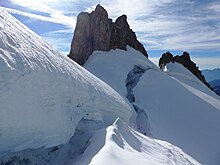




Abergschrund (from the German for mountain cleft) is a crevasse that forms where moving glacier ice separates from the stagnant ice or firn above.[1] It is often a serious obstacle for mountaineers, who sometimes abbreviate "bergschrund" to "schrund". Bergschrunds extend to the bedrock and can have a depth of well over 100 metres (330 ft).
A bergschrund is distinct from a randkluft (also called rimaye), which is a crevasse with one side formed by rock. The randkluft arises in part from the melting of the ice due to the presence of the warmer rock face.[2] However, a randkluft is sometimes called a bergschrund.[3] The French word rimaye encompasses both randklufts and bergschrunds. In a corrie or cirque, the bergschrund is positioned at the rear, parallel to the back wall of the corrie. It is caused by the rotational movement of the glacier. In a longitudinal glacier, the bergschrund is at the top end of the glacier at a right angle to the flow of the glacier. It is caused by the downwards flow of the glacier.
In winter, a bergschrund is often filled by snow from avalanches from the mountain above it. In later summer, due to melting, it lies open and can present a very difficult obstacle to alpinists.
On the South Col route to reach the summit of Mount Everest, a deep bergschrund lies at the bottom of the Lhotse face, separating Camp II from Camp III.[4]
|
| |||||||
|---|---|---|---|---|---|---|---|
| Types |
| ||||||
| Anatomy |
| ||||||
| Processes |
| ||||||
| Measurements |
| ||||||
| Volcanic relations |
| ||||||
| Landforms |
| ||||||
| |||||||